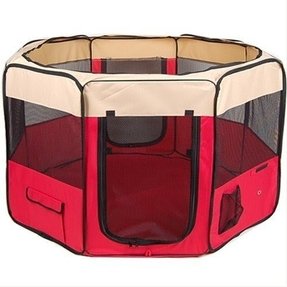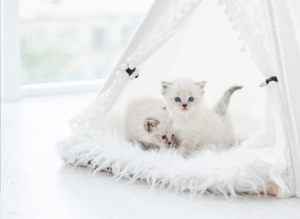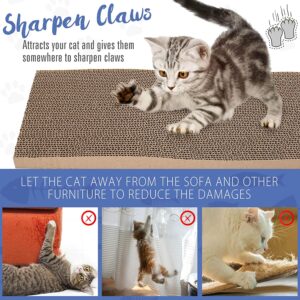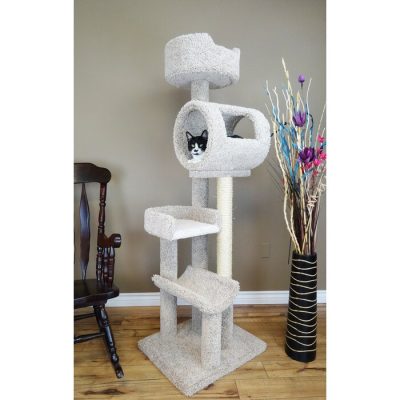Copyright © 2023 Siamese Sweeties, All rights reserved.
Siamese Sweeties & Balinese Beauties
Menu
Kitten Care
Because every kitten deserves purr-fect care!
Bringing home your new kitten? Let our table of contents be your guide!
Introduction
Get ready for one of the most exciting moments in your life—bringing your new Siamese or Balinese kitten home! While it’s easy to get caught up in the excitement, careful planning is key for a smooth, happy transition. These breeds are known for being exceptionally smart, a tad mischievous, and sometimes a bit more needy than your average kitten. This guide offers comprehensive information to make the adjustment as effortless as possible for both you and your uniquely spirited kitten. Early preparation is not just a recommendation; it’s a game-changer. The better prepared you are, the easier it will be for your new kitten to settle in.
Welcome to the Jungle (Your Home); Designing a Kitten-Friendly Zone.
Just like with any new family member, there’s a period of adjustment for both you and your kitten. Use this time to get to know your kitten’s personality and make their transition as smooth as possible. If you notice they’re startled by loud noises, give them a warning before exposing them to such sounds. It’s all part of fine-tuning your life together. Keep in mind that your kitten is also adjusting to you. While they may initially appear shy or unsociable, over time you may find that they are actually adventurous and outgoing. The first week is crucial for making these important adjustments.
Thinking Like a Kitten
By the time they leave, our kittens are able to navigate our home quite well. They generally have free reign during the day and spend the night in a safety proof kitten room. Keep in mind this didn’t happen in a day. The kittens explored little by little, as they learned the house and started feeling comfortable with it. To them our home is their whole world. It can be terrifying for a small kitten to suddenly be taken to a new world with strange people, strange smells and strange noises. To help them adjust you will want to start with a small space at first. The most common choices are a bedroom, bathroom or laundry room. You can also use a small zip up playpen or even a large dog crate. This works especially well in homes with other pets and small children. It gives the kitten a safe place to observe from and meet their new siblings without feeling threatened.
A small zip up kitty play pen can help keep your little one safe as they adjust to their new home


Babyproofing, But Make It Kitty
Before your new kitten arrives, it’s vital to kitten-proof your home. Examine each room carefully, and consider getting down on all fours to spot potential hazards from a kitten’s perspective. Here are some universal precautions to take.
- Hide Electrical Cords: Electrical cords can be deadly if chewed. Focus on thinner cords that might be easier for your kitten to bite through.
- Secure Heavy Objects: Throughout the house, ensure that furniture and shelves are stable and that heavy or breakable objects are secure or removed.
- Toxic Plants and Foods: Ninety percent of houseplants are toxic to cats. Keep them out of reach. Foods like chocolate and sugarless gum can easily poison them. Small Objects: Keep anything swallowable out of reach.
- Cleaning Supplies: Lock these away; many are toxic.
- Open Windows: Secure these; cats can jump or fall
- Water Hazards and Laundry Rooms: Close toilet lids and avoid standing water. Never leave the washing machine lid open and check your dryer before you start it. Make sure your dryer vent is secure to the wall, so little ones can’t access the outdoors by pulling it off.
- Identification: Even indoor cats benefit from microchipping and ID collars.
- Play Zones: Create safe spaces with toys and scratching posts. When they have their own area to play, they may be less likely to explore unsafe areas.
- Never underestimate a kitten’s knack for mischief. Always keep a vigilant eye, especially during the initial adjustment period.
The Castle Awaits: Making Your Home a Kitty Wonderland
Once you have finished kitten proofing the next step will be creating an area they will feel safe and secure. Kittens have the instinct to seek covered shelter. In the wild, they can easily become prey to birds hunting overheard. You will want to create a covered area for your kitten that they can escape to if they start to feel anxious. There are many different ideas, ranging in price and size. It can be as simple as a cardboard box, you can also purchase a fancy cat house or use a covered cat bed. Some cat climbers have hidey houses built in that work perfectly. You can also use a dog crate with the door off or propped open and covered with a blanket to make it private. Just something where they can go and have private time, especially during their adjustment period. If you use a playpen, be sure to give them a covered place inside where they can have privacy when they want it. Also make sure they have something soft to lay on, you could use a cat bed, cushion, or even just a folded blanket. I recommend putting a few around. At least one in their private place and one more in the open for when they want to be more sociable.
Dreamland: Where Kitty Zzzs Meet Sweet Peas
Creating a secure and comfortable sleep haven is essential for their well-being. To begin with, a covered space is crucial to offer the privacy and safety kittens naturally seek, especially in new surroundings. Consider a “kitty cave” or a covered cat bed, placed in a quiet corner away from the hustle and bustle of household activity. This enclosure will serve as their sanctuary, providing a much-needed retreat where they can relax and feel secure. The cover acts as a shield, giving them a sense of safety while they observe their new world. Along with the cover, make sure to include some soft bedding, perhaps even a piece of your own clothing, to offer familiar scents that can comfort them. Their sleeping area is not just a resting spot; it’s a cornerstone in building their confidence and trust as they acclimate to their new family and environment.
The Litter Box
We experimented with just about every litter and every system out there. Some work quite well and others, not so much. For years not much really changed. Nothing worked as well as the good old clay litter. It wasn’t until quite recently a cattery we work closely with mentioned they were trying out a new litter system that used Pine Pellet litter. After some initial research it looked really promising. So we decided to give it a try. I just put out a couple boxes of the pine litter alongside the regular litter boxes and to my surprise the cats took to using it quite willingly. I then noticed cleaning out the pine litter boxes were a little easier than the clay ones and I noticed less smell,
much really changed. Nothing worked as well as the good old clay litter. It wasn’t until quite recently a cattery we work closely with mentioned they were trying out a new litter system that used Pine Pellet litter. After some initial research it looked really promising. So we decided to give it a try. I just put out a couple boxes of the pine litter alongside the regular litter boxes and to my surprise the cats took to using it quite willingly. I then noticed cleaning out the pine litter boxes were a little easier than the clay ones and I noticed less smell,
Using Pine Litter
Pine pellet litter works a little differently than your regular clumping litter. When wet, the pine pellets break down to a sawdust-like consistency. You’ll want to purchase a sifting litter box to sift out the broken down pine when you clean your box. I have found the Arm a nd Hammer sifting litter box to work the best. I also have a couple of the extra-large Tidy Cat Breeze litter boxes. These work well with the pine pellets and a large enough for any size cat. To clean your boxes, first you’ll need to scoop out the feces. You’ll need a scooper with larger than average openings for the pine pellets to fall through. The Tidy Cat Breeze Scoopers work well. After you finish scooping, you’ll use the sifter to sift the broken down pellet dust out and toss it away, which leaves only intact, clean pine pellets behind. I recommended cleaning once a day if you have one box per cat.
nd Hammer sifting litter box to work the best. I also have a couple of the extra-large Tidy Cat Breeze litter boxes. These work well with the pine pellets and a large enough for any size cat. To clean your boxes, first you’ll need to scoop out the feces. You’ll need a scooper with larger than average openings for the pine pellets to fall through. The Tidy Cat Breeze Scoopers work well. After you finish scooping, you’ll use the sifter to sift the broken down pellet dust out and toss it away, which leaves only intact, clean pine pellets behind. I recommended cleaning once a day if you have one box per cat.
Switching Litters
If you do not have a Tractor Supply Company near you, Feline Pine in another good brand that can be found at most pet stores or ordered from Chewy or Amazon. Walmart also carries a pine litter that can be bought in small bags, but it is only offered online. It is recommended to use NON-CLUMPING litter until kittens are about 12 weeks old. This way, if your little one is confused and consumes the litter, it won’t harm their insides. If you plan on switching litters, you’ll want to add a bit of the new litter to the pine pellet litter. Slowly, over time, increase the amount of the new litter and decrease the amount of the old until you are only using the new litter.
Food and Water
Your new kitten will need a food and water bowl. Stainless steel or ceramic is best. Some cats can develop sores on their mouths from the bacteria that grows in the cracks of plastic. Plus the chemicals your cat will be exposed to with plastic are not ideal. I also recommended a water fountain if it is within your budget. They can range from $20 all the way up to $100 depending on how fancy of one you get. Cats love them and it encourages them to drink more. Again, stainless steel or ceramic are best.

Purina Pro Plan
(For Our Siamese & Non-Allergy Families)
We feed our Siamese cats and kittens Purina Pro Plan Premium cat/kitten food. A kitten will eat approximately one, 3 oz can a day and 1/3 cup dry. We usually split this into 2-4 feedings. We highly recommend you continue to feed your kitten Purina Pro Kitten.
Food is an essential factor in the lives of all living creatures. Siamese cats live long and beautiful lives. However, just as with people, pets need to meet their dietary and nutritional requirements to continue living a healthy, and abundant life. Life’s Abundance premium cat food is one of a kind. They make it easy for those that want to provide the best for their furry family member.


Going Home
The Going Home Package
Because we want to give our kittens the best start possible, we send every kitten home with a new kitten package! This will include a whole week’s worth of our premium cat food from Purina, a bag of Pine Pellet non-clumping kitty litter, some fun toys we know our kittens enjoy and a small stuffed toy that will have the scent of their mom and littermates to help them adjust to your new home a little easier.
Transportation Tips
 To give our kittens the best start in their new homes, we provide a “Going Home Package” for each kitten. This package includes a week’s supply of premium Purina cat food, a bag of Pine Pellet non-clumping kitty litter, a selection of toys that our kittens love, and a small stuffed toy infused with the scent of their mom and littermates to ease their transition into your home.
To give our kittens the best start in their new homes, we provide a “Going Home Package” for each kitten. This package includes a week’s supply of premium Purina cat food, a bag of Pine Pellet non-clumping kitty litter, a selection of toys that our kittens love, and a small stuffed toy infused with the scent of their mom and littermates to ease their transition into your home.
The First 48
The first 48 hours after a kitten arrives at its new home can be a rollercoaster of emotions—wonderful, hectic, and even bewildering. It’s important to remember that this is often the kitten’s first experience away from its siblings, amplifying their need for special attention. Many kittens vocalize their anxiety with cries, especially since they’re in an unfamiliar environment and among strangers. However, rest assured that well-raised and appropriately matured kittens tend to adapt quickly. What you observe during these initial hours is not a full reflection of the kitten’s true personality. Sometimes, the shyest or most frightened kittens can transform into the most outgoing or independent family members.
with cries, especially since they’re in an unfamiliar environment and among strangers. However, rest assured that well-raised and appropriately matured kittens tend to adapt quickly. What you observe during these initial hours is not a full reflection of the kitten’s true personality. Sometimes, the shyest or most frightened kittens can transform into the most outgoing or independent family members.
Predicting how a kitten will react in its new setting is not always straightforward. For instance, I’ve witnessed an outgoing, seemingly confident kitten cower in a corner when meeting its potential new family for the first time.
The family was hesitant, questioning whether this was the right kitten for them. I encouraged them to return for another visit. During their second encounter, the kitten’s demeanor completely changed, confirming my initial impressions of its loving and playful nature. Various factors can contribute to a kitten’s initial behavior—anything from not feeling well that day, to lingering discomfort from a recent bath. The key takeaway for new pet parents is to be patient and spend quality time with their new kitten. Shower them with love, affection, and reassurances of safety. Given time and the right environment, they’ll reciprocate with endless love and become an integral part of your family.
Monitoring Your Kitten's Health During Adjustment: Tips and Guidelines
It’s common for your new kitten to abstain from eating, drinking, or using the litter box for 24-48 hours. After arriving at their new home. This is generally not a concern, as the kitten is likely being cautious due to unfamiliar surroundings. They will eat and drink when they’re ready.
Be vigilant for signs of diarrhea or loose stools, which can be stress-induced or sometimes related to lack of eating. While an occasional streak of blood in the stool can be alarming, it’s often normal when diarrhea is present. If these symptoms persist for over two days, think about administering a probiotic. My go-to recommendation is Purina Forti Flora, which you can find on Chewy, Amazon, and in select pet stores. If the diarrhea continues for more than a week, consult your veterinarian to discuss antibiotics for restoring the kitten’s gut bacteria.
Hide-and-Seek
It’s also typical for kittens to seek hiding places in their new environment. To help them acclimate, confine them to a small room or a playpen initially. This makes it easier to locate them if they do hide. If you’re having trouble locating your kitten in your home, the teaser toy with a bell that I’ve included can be an effective way to draw them out. Since they were young, they have been conditioned to respond to this sound for feeding and returning to their pen. If you still can’t find them, check common hiding areas like behind sofas, under beds, in vanities, and drawers, especially if they’ve accessed a bathroom. By observing these guidelines, you’ll help your new kitten adjust to their new home more smoothly.
Purr-fect Playtime
Kittens require ample space to engage in their playful antics—running, jumping, sprinting, and performing all those endearing little maneuvers that make them so captivating. Consider setting up a designated play area where they can unleash their youthful energy. At day’s end, it becomes a delightful playground where you can actively participate in their frolics. Whether you’re swatting at dangling toys or engaged in a lively game of chase, this space offers an excellent opportunity for you and your kitten to connect, bond, and just have a whole lot of fun together.
Having a designated play area not only helps kittens adjust to their new environment but also keeps them out of mischief. When they have their own special zone filled with toys and stimulating activities, they’re less likely to explore areas they shouldn’t. A content and engaged kitten is far less likely to become restless, bored, and subsequently adventurous in unwanted ways. Not in words but they will thank you for taking the time to learn about the joys and practicalities of providing Then. Their own little utopia.
Cat Scratchers and Climbers
Cat scratchers are an often-overlooked necessity. Many people only realize their importance when kittens start using furniture as a scratching post. Contrary to popular belief, cats don’t just enjoy scratching; they need to do it. Think of it as their version of stretching after a long rest.
 I recommend starting with at least two types of scratchers: one that stands upright and another that lies flat on the ground. Some cats enjoy stretching fully while scratching, while others prefer short bursts along the ground. You might even find that your cat uses both!
I recommend starting with at least two types of scratchers: one that stands upright and another that lies flat on the ground. Some cats enjoy stretching fully while scratching, while others prefer short bursts along the ground. You might even find that your cat uses both!
Opt for a sturdy stand-up scratcher, and consider one that combines with a cat climber for added enrichment. For the ground-level scratcher, cardboard ones are a hit with my cats.
Place these scratchers in visible areas; cats like to show off their “mighty” scratches as if warding off imagined predators. While it’s okay to place a scratcher near your furniture, never attach one to it. Some products are designed to be affixed to the sides of your sofa, but this teaches cats to scratch the furniture. Instead, use plastic shields or sticky tape to discourage them from scratching your sofa as they learn.
 Cats and kitten love to climb! I highly recommend you look into a cat tree/condo/climber. We have owned many of them and want to offer our advice to those looking. Most cats like to climb high, so a good high pedestal is fun, the baskets are usually a big hit as are hammocks and hidey houses. The toys attached by strings always break, but aregreat fun for the week or so they last. Some are on the cheaper end, work great for kittens, and not so much for adult kitties. They are smaller, and they use particle board and faux fur. They work great for immediate needs, but don’t last very long. Your kitten will probably outgrow it around 7-8 months. By that time it may be looking a little shabby too. The faux fur tends to shed, doesn’t clean well. If you want something that is going to last through years and years, you probably want something with wood and real carpet. It will be a bit more expensive, but personally We think it’s worth it. However, if you want something smaller that will work for just the kitten years, Walmart, Amazon, Chewy and other sites has some cheap ones at around $50 or less.
Cats and kitten love to climb! I highly recommend you look into a cat tree/condo/climber. We have owned many of them and want to offer our advice to those looking. Most cats like to climb high, so a good high pedestal is fun, the baskets are usually a big hit as are hammocks and hidey houses. The toys attached by strings always break, but aregreat fun for the week or so they last. Some are on the cheaper end, work great for kittens, and not so much for adult kitties. They are smaller, and they use particle board and faux fur. They work great for immediate needs, but don’t last very long. Your kitten will probably outgrow it around 7-8 months. By that time it may be looking a little shabby too. The faux fur tends to shed, doesn’t clean well. If you want something that is going to last through years and years, you probably want something with wood and real carpet. It will be a bit more expensive, but personally We think it’s worth it. However, if you want something smaller that will work for just the kitten years, Walmart, Amazon, Chewy and other sites has some cheap ones at around $50 or less.
Naming Your New Friend
A very common question we get asked is if we mind when families change their name. We use fun little nicknames for our kittens rather than just calling them by their collar color, although we have used color names before (we still think of you Greeny and Reddy!). These are just fun temporary names we use to set them apart until we learn their forever names from their new families. So please name away and share it with us. We love learning all the fun, unique and silly names our families come up with. Thinking of you, Sassafrass!
Introducing Your New Kitten to a Resident Cat
The process of introducing your new kitten to a resident cat can vary greatly, influenced by their individual personalities and ages. You can start the introduction whenever you feel both cats are ready. If you encounter excessive hissing and growling during this initial meeting, it’s advisable to separate them and try again later.
 Scent is a crucial factor in feline socialization, so consider swapping blankets or beds between the two cats to help them get used to each other’s smell. This will likely make subsequent interactions smoother. When reintroducing them, aim for positive times like mealtime or playtime and make sure each cat has their own resources like bowls and toys to prevent competition.
Scent is a crucial factor in feline socialization, so consider swapping blankets or beds between the two cats to help them get used to each other’s smell. This will likely make subsequent interactions smoother. When reintroducing them, aim for positive times like mealtime or playtime and make sure each cat has their own resources like bowls and toys to prevent competition.
Always supervise their interactions initially.  When you’re not around to keep an eye on them, keep the cats in separate rooms. They can still get to know each other by sniffing and pawing under a closed door.
When you’re not around to keep an eye on them, keep the cats in separate rooms. They can still get to know each other by sniffing and pawing under a closed door.
If a serious altercation occurs, especially among older cats, exercise caution in future introductions. Both cats will need time to cool off and adjust to each other’s scent again. While rough play is common and generally acceptable, it shouldn’t be mistaken for fighting. In actual fights, you’ll often hear loud growling, hissing, and screaming.
To help each cat feel more secure, designate specific retreat areas where they can escape to when they need alone time. This can be a high shelf for the older cat or a small, enclosed space that only the kitten can access.
Keep swapping the scents and allowing them to see each other as a means of gradually building patience and controlled exposure. Aim to do this during positive times in their day. Typically, a week is all it takes to notice a significant improvement in their relationship. By following these guidelines, you’ll be setting the stage for a harmonious relationship between your new kitten and your resident cat.

